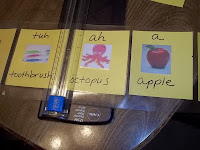 |
| My set of homemade cards |
If the cards are barely known to me today I was totally oblivious of them 7 years ago when I began doing therapy for my oldest child. I made cards using 4x6 photos and construction paper, which I laminated. When that got tedious I switched to sticky notes. Like bugs, they landed on walls, furniture, appliances, toys, shelves, they were everywhere!
Fast forward seven years. Today, my 9 year old(Ashi) has excellent speech, but my second child with ASD, SPD, and apraxia of speech and muscles is ready to start some therapy. Unfortunately my old cards are outdated and impersonal to Izaiah. The sticky notes are are all curled and have lost their 'sticky', I can't believe I even saved them! It was time for some new cards.**
 |
| 6 equal squares |
2.) Using colored construction paper, I divided the paper into half along the length, and then in thirds along the width to make 6 squares on each piece. I put sounds on yellow, people on orange, and objects on blue. (Optional: you don't have to color-coordinate and white paper is fine.)
 |
| Pictures glued on and laminated |
3.) Cut out all the squares with a paper cutter or scissors.
4.) I gathered photos from my own collection and a few from the internet. I made a new 'flashcards' file on my computer and put all the images there.
5.) I printed the images on regular white paper using the "print 20, size 2x2" option on my printer's menu. They turned out pretty good. You could print them on photo paper for better quality.
 |
| Cutting and trimming |
7.) I trimmed the laminated cards with a paper cutter. You can use scissors, but a paper cutter with a blade is much smoother and neater.
 |
| Hole punch on left top corner |
8.) Last, I used a hole punch to put a hole in the upper left hand corner and put them all on a metal ring. This makes them portable, which is important because autistic, apraxic, preschoolers don't quietly sit at the table with their hands folded to do flashcards. Oh, no! You have to be on the move and catch them while they are self-stimming with rocks, lining up blocks or dinos, sliding downstairs face first, or running a path into your carpet! You will get your best work done when you sneak 'therapy' into play.
Some of the sounds I used were: a (apple), ah (octopus), buh (ball), juh (jump.juice), puh (puppy), vuh ( vest), muh (mommy, macaw), nuh (no), cuh (cup), oh (open), uh (up), duh (daddy, down), wuh (water), tuh (turtle), etc. These are just a few, but you get the idea. Going through the alphabet and adding (a,e,i,o,u) to the consonant sounds should get you a good stack of sounds which is fundamental to speaking words. If your child is non-verbal the sounds are just as important as the words.
While I can't afford the Kaufman cards, Dr. Nancy Kaufman is making some you-tube videos from her therapy sessions. They are short, sweet, and free! Definitely worth viewing. Click here to watch.
** I got this new twist on making cards from another incredible Mom with a wonderful blog site. Click here to visit, it's so worth it! You will find so much information there! She made her cards directly from the Kaufman cards and so was unable to share the sound cards because of copyright. I, however, have never seen the Kaufman cards, so any duplicates are purely coincidental. I also took "do it yourself" a couple steps further by laminating and cutting my own, you can do it too!
Annie Eskeldson writes for parents of young autistic kids. She's blessed with two who have autism, sensory issues, apraxia of both speech and muscles, adhd, and pbs and xyz (joke!) She's not a professional therapist but plays one at home. You can check out her children's books about autism here Ashi's Gift Website.

No comments:
Post a Comment